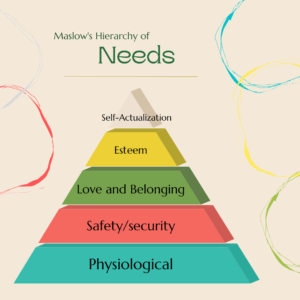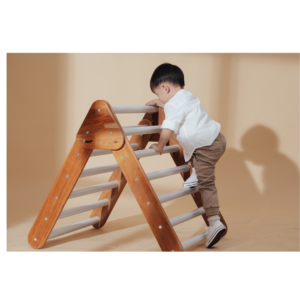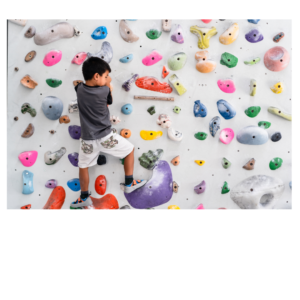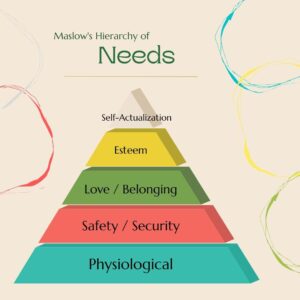When parents and teachers talk about kids with special needs, they are often referring to a specific diagnostic label. A diagnostic label describes the patterns of a child’s behavior. A diagnostic label explains why a child may be struggling in one area of learning academic skills, like reading, writing, or math. Diagnostic labels may be useful in deciding what accommodations or modifications may be helpful for child in a classroom.
Behaviors of Homeschooled Kids with Special Needs
However, many homeschool families either choose not to have an assessment or don’t have access to an evaluator. Instead, homeschool parents can use less formal ways to help their kids with special needs. The clues we see through the behaviors and academic struggles can be seen based on Maslow’s hierarchy of needs.
All kids have strengths and weaknesses. All kids have needs. As homeschool parents who are managing the full program for our kids, we can tell when something just isn’t quite right. So we try our best to figure out what is going on. For kids with special needs, understanding more about how needs motivate behavior can lead us to set better goals and to select the best curriculum for our homeschool.
How to Figure Out Needs from Behaviors
Back in the 1940s, Abraham Maslow suggested that all people are motivated by a progression of needs. Maslow’s hierarchy is a theory that is frequently unknown by the public and gets little attention by educators.
If we are to look at a child’s “special” needs, we can take a look at where the behaviors fall on the pyramid. Knowing the motivation behind behaviors helps us consider the whole child for practical solutions. Don’t get me wrong – diagnostic reports can yield very useful information about how a child learns or struggles. Rather than trying to figure out what a bunch of buzz words in a very technical assessment report mean, we can look at the patterns of how a child acts. Translating assesments into realistic solutions is difficult, so we can use more simple ways to come up with plans.
Click here to get a FREE poster of Maslow’s Hierarchy of Needs

You will want to read this blog post if you are asking,
“How can Maslow’s Hierarchy of Needs help me motivate my kid with special needs?
Maslow created a list of needs that people are motivated to satisfy in order to move to higher levels of functioning. Children are no exception. But kids with special needs often have difficulty communicating their needs in words, so they tell us through behaviors. Interpreting behaviors based on Maslow’s hierarchy can give clues to what goals to work on in a homeschool environment.
First, let’s take a look at the levels of Maslow’s Hierarchy actually are and what they mean for children’s behavior and their needs.
The most basic physical needs are at the base of the hierarchy. The first level is physiological needs include food, water, shelter, hygiene, sleep, and health.
The second level is the need for a sense of safety, both physically and emotionally. Safety needs are first met from nurturing in the first two years of life, a structured environment, and boundaries in relationships that let a child know they are protected by significant care takers. Security is important for a child to feel relaxed and free enough to learn.
The third level is love and belonging. The need of being loved unconditionally and belonging in a family group gives children a solid sense of accepted by the people who mean the most in life.
The fourth level is esteem needs of confidence and value as a human being. Children who live with criticism or with social rejection may struggle even into adulthood to realize their worth to themselves and others.
The fifth level is self-actualization, which means a person can act to meet the needs of others. Parents who are self-actualized are able to put the needs of their children ahead of their own, yet still find time to balance adult relationships and serve society. Children show self-actualization when they are curious, eager to learn new things, and engage in imaginative play and creative activities.
Developmental Domains and the Hierarchy of Needs
You might find it interesting that the needs in Maslow’s hierarchy equate to the developmental domains in which we all function. The five developmental domains are: physical, emotional, social, cognitive, and moral/spiritual.
Physical development can happen when physiological needs are met. When a child is nurtured and given structure in the first two or three years of life, a sense of security and safety develops.
The environment and relationships created by parents and other significant care-takers helps a child take appropriate risks and develop personal security.
Social skills are developed when the need for love and belonging start with parents, then extended family, then to other care-takers, and finally peers.
Emotional regulation and development happens when esteem needs for respect, value, and recognition are met.
Moral and cognitive skills are developed when adults model for children the curiosity for learning, creativity to try new things, and altruistic acts of kindness toward others.
Meet needs based on developmental levels.
Unfortunately, kids with special needs often are out-of-sync in one or more developmental domain from the stages that neurotypical kids pass through. When a developmental domain is out-of-sync with other domains, a child’s behavior may indicate what needs to address with solutions that match the child’s developmental level of that domain.
What that means is if a child is having difficulties with self-esteem and social relationships, you must go back to more basic needs that are intact. Look at the physiological needs. Then look at safety and security needs. Build strong bonds through intentional connecting family activities. The child will learn from you how to be social.
Some kids with special needs just don’t pick up social skills, even with strong family bonds. When a child has difficulty getting along with other, using a social skills or character-building curriculum can give the child tools to practice. Even small skills contribute to the child feeling more confident and respected.
Of course, anytime a child’s behavior is out-of-sync with their chronological age, it is important to consider developmental domains to satisfy their needs in the related hierarchy levels.
A Real-life Story
Telling a kid to “act your age” really does nothing productive because a child whose behavior is out-of-sync with development cannot and will not behave in an age-appropriate way until those needs are met.
Here’s an example. We had a foster child who came to us at age 4. He had been malnourished and was very tiny. His eating habits were unusual because he craved only McDonald’s chicken nuggets and smothered all foods in Ranch dressing. There were a lot more food issues, but the cravings were huge. He got sick a lot and had a lot of trouble sleeping. He seemed happy much of the time. Yet he didn’t really know how to play with toys and based imaginary play on horror movies. In the evenings, he quickly turned fearful and clingy.
Getting results
We built on the love and belonging level since that was somewhat intact. First, we worked on the safety needs. We held him a lot. I would rock him to sleep as if he were an infant. He loved for me to rock him and sing happy, gentle songs to him. We allowed him to put imaginary weapons around the perimeter of his bed because he was in such need of safety and protection. We also assured him that he was safe, the adults would take care of him, and that he would have enough to eat.
It took about 6 months, but finally, he would eat a balanced meal, stopped having night terrors, and used less toy weapons to surround his bed. He was 4 ½ when he left us and ready to bond with his new family. He was had the confidence to continue to grow and begin learning.

By the way, a child or adult with an intellectual disability or developmental delay may actually have satisfaction in all five levels of needs, as long as those needs are met in a meaningful way to the individual according to their developmental capabilities. Goals are set to continue training in all five domains and for all five levels of needs.
Q and A about how it’s done!
Q. So what if my kid is a very picky eater?
A. Perhaps your child’s special needs involve physiological needs.
Some kids have significant digestive issues which can alter tastes. A child with anxiety issues may have a fear of choking, so safety needs may be driving a child’s rejection of certain foods.
A child who has previously been in the foster system may hide food under a bed. In this case, certainly a drive for hoarding food for the future could stem from a very real physiological need. Over time this same child may continue to save food through a need for belonging by replacing food for attachment with people.
Q. So what if my child likes to jump off high places like the roof of a shed or our house?
A. This is definitely a safety need.
A hyperactive child with ADHD may be lacking the brain filter that gives them a sense of danger. The behavior tells you that there is a disconnect between knowing and following safety rules.
This is a strong indicator that you will want to set a homeschool goal of teaching the inner self-talk specifically about how high a surface can be for jumping. In the meantime, you will want to be vigilant to monitor that kiddo closely while you are working on that goal.
Q. So what if my child is struggling in learning to read? How is Maslow’s hierarchy going to help with reading?
A. This problem could lie in several levels of the hierarchy of needs.
The skill of reading is a complex brain task that involves the auditory and visual systems, as well as executive functions in the frontal lobe. When a child struggles in learning any academic skill, we want to look at the physiological needs first.
Have vision and hearing checked first.
Then check whether the child been scolded or teased for not reading. Ensure the needs for emotional safety and belonging that you know they are trying, and you will be patient.
Specific, explicit instruction using multisensory activities can help the brain see the patterns in language and use strategies for sounding out words or comprehending what has been read. Keep the lessons short and comfortable. Start where the child’s skill is and work toward mastery of each skill. That initial success will satisfy multiple levels of needs. Once success is started, success builds more success! That’s when you know you are on the right track.

How to set goals from the hierarchy of needs:
We know that the hierarchy of needs can reveal the motivation behind behaviors. We can use the hierarchy to help figure out when a child’s behavior is not falling into a neurotypical pattern. The lower on the need pyramid a child’s behaviors fall, the more basic our goals need to be.
Sample goals
- Physiological Needs, like physical health and hygiene
Appropriate goals based on Maslow’s hierarchy in a special needs homeschool may include:
Example: My teen will take a shower at least 4 times a week
- Safety/Security Needs, such as chores to keep the home clean and safe
Example: My child will play with Legos on a blanket/mat and put them away in the storage bucket.
- Love and Belonging Needs, through social skills training
Example: My child will invite one other kid to play on Wednesday park days.
- Esteem Needs through encouragement, as well as emotional coping strategies through cognitive behavior training or DBT skills
Example: My teen with anxiety will attend and participate in karate lessons 2 times per week.
- Self-Actualization Needs by using a curriculum that matches your child’s learning needs, allows for creative activities, and encourages community service.
Example: My child will make one art project each week.
Beyond Maslow’s Hierarchy of Needs to Brain-Based Learning
When I set goals, I typically consider a combination of Developmental Domains, Maslow’s Hierarchy of Needs, Bloom’s Taxonomy of Thinking Skills, and Gardner’s List of Multiple Intelligences. Watch for future blog posts that explain each of these theories of learning. Theories are just that – a theoretical basis for how researchers think development and learning takes place. I use those concepts and combine them with the deep knowledge of my kids (that most moms have), then seek out ideas for how I can apply practical solutions to helping my child learn and grow to be more in-sync and fulfilled in whatever capacity each one can reach.
I’m so eager to share what we’ve done with you!

